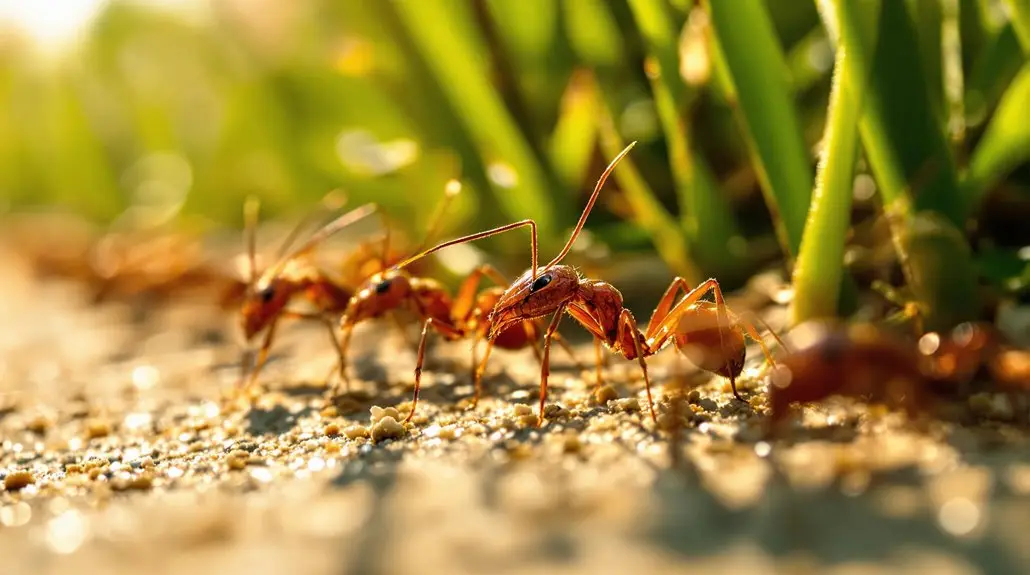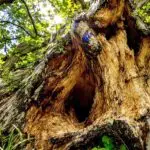Research by Vander Meer, Alonso, and Lofgren indicates that light considerably impacts the homing abilities of foraging workers of *Solenopsis invicta* in Florida. Under low light levels, these ants successfully navigate back to their nests; however, complete darkness severely disrupts their trail formation and navigation efficiency. The study found that fixed light sources enhance their homing skills, allowing quicker trail formation compared to unstable lighting. Remarkably, the color of light also influences their navigation, with white light aiding in faster orientation over red light. Such findings are essential for understanding the ecological implications of fire ant behavior and management strategies.
Key Insights
- Low light levels (1 lux) do not hinder the navigation of fire ants back to their nests effectively.
- Complete darkness impairs trail formation and navigational efficiency in fire ants.
- Stable light sources enhance trail formation speed and improve homing abilities compared to unstable lighting conditions.
- White light accelerates trail formation, while red light still supports navigation but less effectively.
- Understanding these light influences can aid in developing targeted control measures for managing fire ant populations.
Foraging Behavior Overview
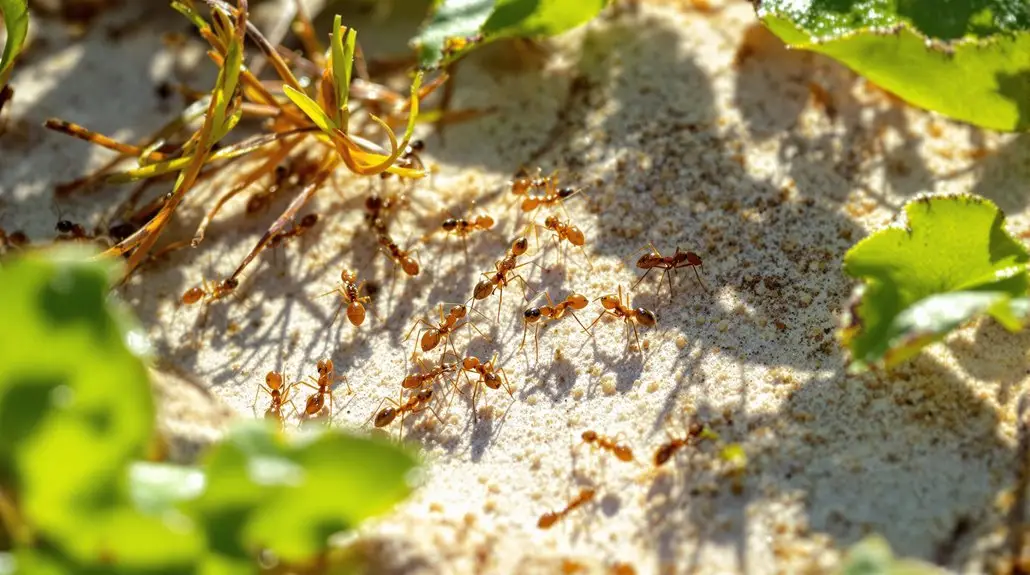
When you observe the foraging behavior of _Solenopsis invicta_, it’s clear that these ants have unique strategies that enhance their efficiency. These fire ants demonstrate marked preferences for certain surface types, showing higher foraging efficiency on hard, smooth plastic surfaces rather than on soil. When traversing obstacles such as gravel or grass, their foraging efficiency plummets, with grass surfaces causing a significant reduction in activity compared to gravel.
Curiously, wild colonies outshine their one-year-old laboratory counterparts regarding foraging success, highlighting the influence of environmental conditions on their behavior. Environmental factors like temperature play an essential role in foraging activities, particularly soil temperature at 15 cm depth, which serves as a significant predictor for their efficiency. Additionally, the species’ ability to thrive in various climatic zones enables them to adapt to diverse environmental conditions effectively. Moreover, their foraging behavior can be influenced by eco-friendly pest control practices that reduce the use of harmful chemicals in their habitats.
Additionally, seasonal weather variations, including rainfall, impact their foraging behavior, while vegetation structure, food availability, and abundance also dictate their success. The foraging strategies of _Solenopsis invicta_ incorporate a sophisticated network of tunnels beneath the soil, allowing foragers to move swiftly and effectively across their territory.
They lack route-faithfulness, meaning they can be recaptured at any point within their foraging area. Recruitment to food sources is rapid and localized from these tunnels, allowing the colony to adapt quickly to changing conditions. These dynamics illustrate the complex interplay between environmental factors and the ants’ foraging behavior, a demonstration of their adaptability and efficiency as they seek out resources essential for their survival.
Influence of Light Intensity
When studying the influence of light intensity on the homing abilities of Solenopsis invicta, researchers found that even low light levels, as minimal as 1 lux, don’t hinder the ants’ capacity to navigate back to their nests effectively. In contrast, the presence of a fixed light source markedly reduces the time it takes for the ants to form trails compared to complete darkness, highlighting the importance of light in their foraging behavior. Consequently, understanding how different light intensities affect trail formation and homing can provide valuable insights into the foraging strategies of these ants. Additionally, the study demonstrates that light orientation is vital for fire ant foragers returning to the nest.
Homing Under Low Light
Light intensity plays an essential role in the homing abilities of fire ants, especially under low light conditions. Fire ants rely on light as a powerful cue to navigate back to their nests after foraging, enabling them to orient directly toward their home rather than retracing their previous paths.
Remarkably, even a faint light source, such as moonlight at 1 lux, allows these ants to maintain their homing abilities. It’s remarkable that low light conditions don’t considerably hinder their capacity to form trails or return home, indicating a robust adaptation to varied lighting environments. Additionally, their reliance on environmental cues enhances their navigation skills, allowing them to successfully locate their nests.
However, the stability of the light source is critical; a fixed light enables efficient navigation, while a rotating light can disrupt their ability to form trails and orient themselves.
When light is absent, as in complete darkness, the fire ants struggle considerably, taking longer to form trails and relying on less effective navigation cues. This highlights the importance of light not merely as an environmental factor, but as a key element in the fire ants’ homing mechanism, ensuring their successful return to the nest even when conditions are less than ideal.
Light Intensity Comparison Results
Under varying light intensities, fire ants demonstrate remarkable adaptability in their homing abilities. When researchers examined the effects of a fixed light source, they found that this stable cue allowed the ants to orient back to their nests efficiently, showing no degradation in their homing skills.
In contrast, when exposed to darkness, the time taken for trail formation increased considerably, indicating that the absence of light hampers their ability to navigate effectively. Even at low light levels, equivalent to moonlight at 1 lux, fire ants maintained their orientation back to the nest, emphasizing their reliance on light cues. Interestingly, when researchers tested red light, they discovered that fire ants couldn’t distinguish it from complete darkness; therefore, it didn’t contribute to their homing ability. This suggests that the primary factor influencing their navigation isn’t the color of the light but rather its presence. Additionally, these findings align with the concept that nocturnal ants have evolved specific adaptations to enhance navigation in low-light conditions.
Effects of Light Color
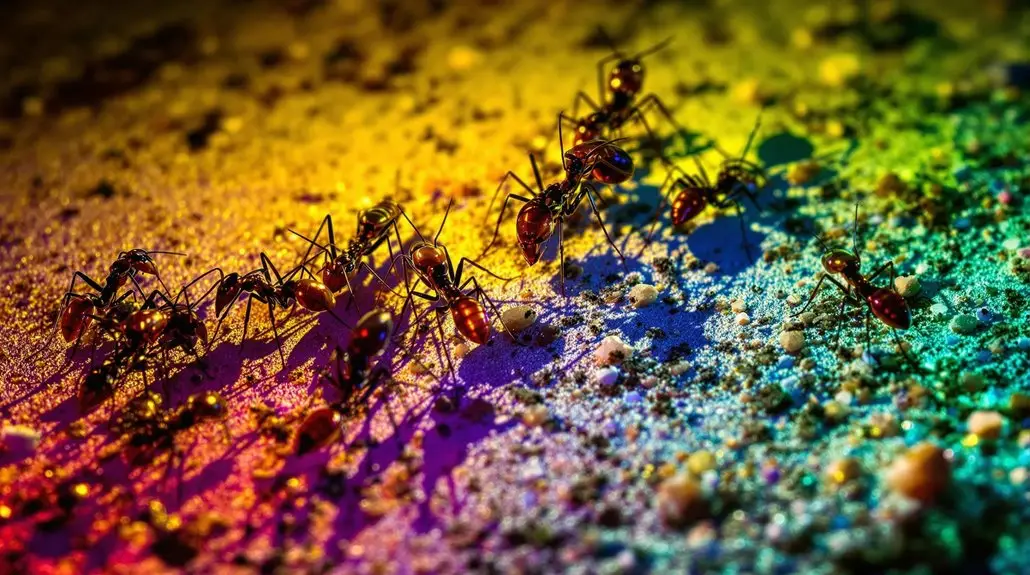
When examining the effects of light color on the homing ability of fire ants, it becomes clear that the type of light can greatly influence their orientation cues.
While white light facilitates quicker trail formation, red light fails to enhance their homing efficiency, resulting in performance similar to that observed in complete darkness.
Understanding these differences in light color effects not only sheds light on the ants’ behavioral adaptations but also highlights the importance of stable light sources in their navigation processes.
Color Impact on Homing
In studying the effects of light color on fire ant homing, researchers found that the presence of a stable light source is far more essential than its specific color. The key takeaway is that fire ants rely primarily on light as a cue for orientation back to their nests, regardless of whether that light is red, blue, or green.
When a fixed light source is present, visual cues from the surrounding environment become irrelevant, showing that light stability overshadows color differences.
Interestingly, even at low light intensities, such as 1 lux, fire ants demonstrated efficient homing abilities. This indicates that while light color doesn’t greatly impair their navigation, the intensity and consistency of light play a critical role.
In contrast, rotating lights disrupt the ants’ trail formation and homing efforts, illustrating how changes in light conditions can hinder their natural behaviors.
Red Light Effectiveness
Many studies show that red light effectively supports fire ant homing abilities, maintaining their efficiency even in low light conditions. Research indicates that when fire ants are exposed to fixed red light, their ability to navigate back to their nests remains consistent, similar to conditions of complete darkness. In fact, light intensity as low as 1 lux, akin to moonlight, doesn’t impair their homing skills.
Unlike other light colors or intensities, red light doesn’t degrade their trail formation capabilities, allowing foraging workers to orient themselves back to their nests without confusion. Importantly, the presence of a fixed light source enhances the ants’ homing efficiency, while rotating light can disrupt trail formation, highlighting the importance of stability in light conditions.
The ants rely heavily on fixed sources of red light to guide their journeys, reducing the need to retrace random foraging paths. Consequently, red light serves as a reliable cue in the complex recruitment system of fire ants, facilitating their efficient return home and reinforcing the idea that light is a vital factor in their foraging behavior. Additionally, ants utilize visual landmarks during navigation, which may interact with the effects of red light to further enhance their homing abilities.
Challenges of Rotating Light
The challenges posed by rotating light greatly disrupt fire ants’ ability to navigate back to their nests. These ants rely heavily on stable light sources for orientation, and when exposed to rotating light, their homing cues become confused and ineffective. As a result, fire ants struggle to form trails, which are essential for efficient foraging and returning to their nests.
Here are some key points regarding the impact of rotating light on fire ants:
- Rotating light inhibits the formation of reliable trails, causing delays in nest return.
- Fire ants depend primarily on fixed light sources to establish a consistent direction.
- The instability of rotating light leads to increased energy expenditure and inefficiency.
- Under rotating light, fire ants may abandon foraging activities altogether due to confusion.
- Compared to fixed light, rotating light considerably extends the time needed for trail formation.
- The reliance on stable light sources for navigation is crucial for many insect species, influencing their foraging success.
In various experiments, it’s evident that the visual cues provided by stable light are far more effective than those from a rotating source. Additionally, the impact of artificial light at night on insect navigation can lead to further challenges in ecosystems where fire ants are present.
Even under low light conditions, such as 1 lux, fire ants can navigate effectively if the light remains constant. Conversely, the rotating light disrupts their visual orientation, leading to behavioral changes that hinder their foraging efficiency.
Thus, understanding these challenges is vital for anyone studying the foraging behavior of Solenopsis invicta, as it highlights the importance of light stability in their navigation and overall foraging success.
Experimental Methods Utilized
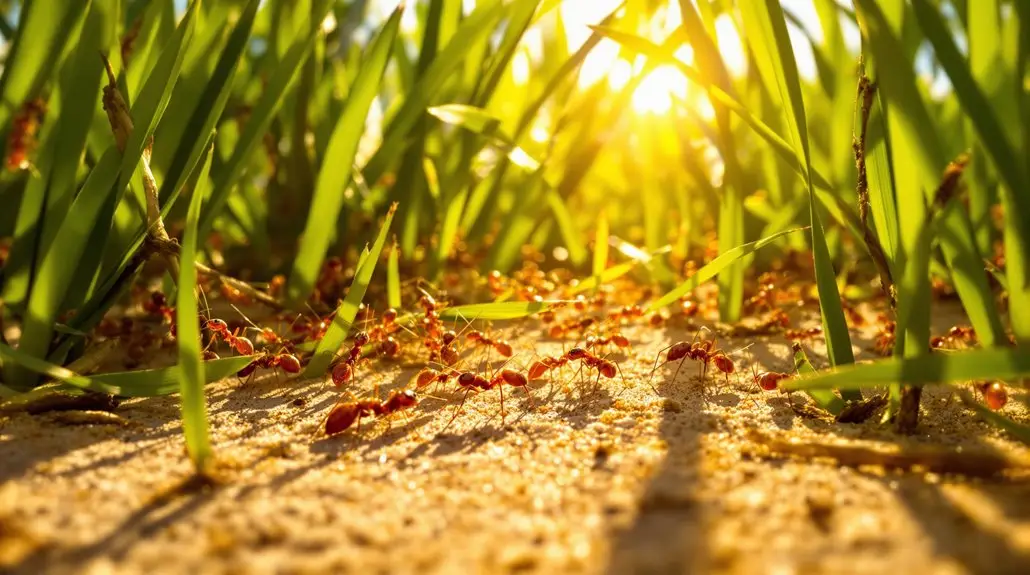
Experimental methods for studying the foraging behavior of *Solenopsis invicta* involved a carefully designed setup to assess how various light conditions affect their navigation. Researchers collected colonies from monogyne field sites in Florida or generated them from newly mated queens. They conducted experiments on a bioassay tray with the nest cell at one end, using fixed lights attached to the ceiling or a rotating turntable above the tray. Light intensity was controlled through a Variac® voltage regulator and measured with a Weston Illumination Meter to guarantee accuracy.
The experiments tested various light intensities, ranging from 0 Lux (complete darkness) to 312 Lux, measuring the time required for trail formation. Additionally, they examined different light colors—white, blue (~475 nm), yellow (~570 nm), and red (~650 nm)—to observe color-specific responses.
Here’s a summary of the experimental conditions:
| Light Condition | Lux Level | Time-to-Trail Formation (seconds) |
|---|---|---|
| Complete Darkness | 0 Lux | X seconds |
| Low Light (moonlight) | 1 Lux | Y seconds |
| Bright Light | 312 Lux | Z seconds |
| Red Light | 650 nm | A seconds |
Through these methods, researchers analyzed the effects of light on trail formation, presenting a thorough understanding of how light influences the foraging behavior of *Solenopsis invicta*, enhancing the knowledge of ant navigation strategies in diverse environments.
Ecological Significance of Findings
Understanding how *Solenopsis invicta* navigates in various light conditions sheds light on the broader ecological implications of their foraging behavior. The ability of fire ants to efficiently return to their nests after locating food directly influences their resource gathering strategies, which can have significant effects on both their colony dynamics and the surrounding environment.
Consider the following ecological impacts:
- Efficient foraging enhances food distribution within large colonies, which can exceed 200,000 individuals.
- Light cues support the complex recruitment system, ensuring that food reaches all colony members effectively.
- The ability to forage both day and night allows fire ants to exploit available resources without significant impairment from low light levels.
- Fire ants’ preference for underground plant tissues can lead to substantial damage to agricultural crops.
- Their foraging behavior can disrupt local ecosystems, negatively impacting native flora and fauna.
As fire ants efficiently utilize light for orientation, this behavior demonstrates their resilience to control measures, necessitating more targeted management strategies. Additionally, their presence can complicate efforts to manage other pests, such as roaches(https://example.com/roaches), which can thrive in similar environments.
Research indicates that integrating knowledge about their homing mechanisms can improve detection and prevention efforts. Consequently, understanding these ecological implications not only enriches our comprehension of fire ant behavior but also guides effective management practices. By applying this knowledge, researchers can develop targeted fire ant control methods that are environmentally friendly and more efficient. This approach not only minimizes the impact on non-target species but also enhances the sustainability of ecosystems where fire ants are prevalent. As a result, landowners and agricultural producers can implement strategies that effectively manage fire ant populations while preserving biodiversity. Furthermore, the incorporation of innovative solutions, such as green nanopesticides in pest control, offers a promising avenue for reducing reliance on traditional chemical pesticides. These eco-friendly alternatives have the potential to specifically target fire ants while safeguarding beneficial insects and overall ecosystem health. As awareness of sustainable practices grows, more landowners and producers are likely to adopt these methods, leading to a more balanced coexistence with the environment. Additionally, research into natural compounds for fire ant control has shown promise in providing effective solutions that align with ecological principles. By harnessing the power of nature, these strategies can foster a healthier environment while significantly reducing fire ant populations. As these natural alternatives gain traction, they may pave the way for more sustainable and holistic approaches to pest management in diverse landscapes.
Frequently Asked Questions
What Is the Natural Habitat of Fire Ants in Florida?
Imagine stepping into a bustling city where fire ants establish their homes in Florida’s sunny landscapes.
These industrious creatures thrive in open areas like lawns, fields, and pastures, favoring well-watered spots near rivers and potted plants. Their dome-shaped mounds, crafted from soil, serve as nurseries while regulating temperature and moisture.
Adaptable, fire ants can even nest in unexpected places, like electrical equipment, ensuring their survival in diverse environments.
How Do Fire Ants Communicate With Each Other?
Fire ants communicate using a combination of pheromones, tactile interactions, vibrations, and visual cues. They release pheromones to mark trails and signal danger, while antennation allows them to exchange chemical signals and recognize nestmates.
Additionally, they produce vibrations as alarm signals and utilize body language, such as raising their abdomens, to convey specific messages. This multifaceted communication system guarantees effective coordination among nestmates, enhancing their survival and efficiency in foraging activities.
What Predators Threaten Fire Ant Colonies?
Imagine fire ants as unwelcome guests at a party, yet there are natural predators ready to crash that gathering. Among these, phorid flies, particularly *Apocephalus* species, threaten fire ant colonies by laying eggs in their heads, ultimately killing the ants as the larvae develop.
This method of predation highlights the potential for ecological control. Researchers are actively exploring the introduction of these flies to help manage fire ant populations in North America.
How Do Temperature Fluctuations Affect Fire Ant Activity?
Temperature fluctuations greatly impact fire ant activity. When temperatures range between 65°F and 95°F, you’re likely to observe peak foraging.
However, if temperatures drop below 34°F for several days, fire ants may greatly reduce their populations or even perish.
Soil temperatures also play an important role; at around 29°C, foraging is ideal.
Therefore, maintaining suitable conditions is essential for sustaining active fire ant colonies in their environment. In addition to providing suitable conditions, effective management strategies can help regulate their population. For instance, incorporating essential oils for fire ant control has gained popularity due to their natural repellent properties. These oils can disrupt the ants’ communication and foraging behavior, promoting a healthier ecosystem while minimizing the reliance on synthetic chemicals.
What Is the Lifespan of a Fire Ant Worker?
The lifespan of a fire ant worker typically ranges from 1 to 6 months, depending on factors such as size and environmental conditions.
Small workers usually live for about 1 to 2 months, while larger workers may survive up to 6 months.
As they age, their roles within the colony shift, with older ants primarily taking on foraging duties, which can lead to a considerably shorter lifespan once they begin this intensive activity.
Final Thoughts
To sum up, the research by Vander Meer, Alonso, and Lofgren demonstrates that light greatly influences the homing behavior of Solenopsis invicta foragers in South Florida. By manipulating light intensity and color, the researchers observed notable changes in foraging patterns and navigation efficiency. These findings underscore the importance of environmental factors in shaping ant behavior, providing critical insights that could inform pest management strategies and enhance our understanding of ecological interactions within their habitats.
Illuminate Your Understanding: The Light Factor in Ant Behavior
As you consider the implications of this research, let it guide your pest management strategies. For effective solutions tailored to your environment, trust NaturePest Holistic Pest Control. Our approach integrates scientific insights with eco-friendly practices to create a harmonious balance in your South Florida ecosystem. Don’t let pests disrupt your peace—reach out to us today for a consultation!

